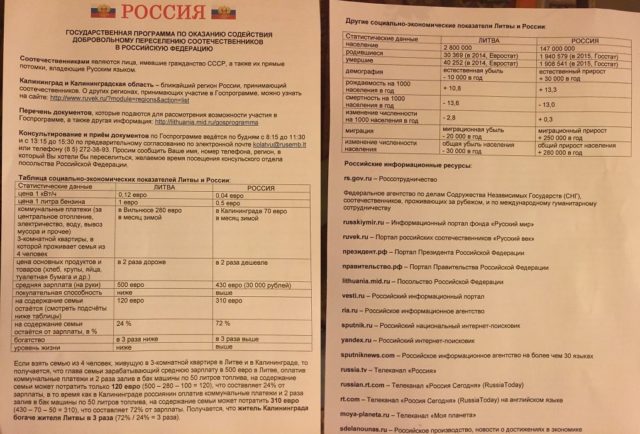
Lithuania: The Old-New Target of Russian ‘Hybrid Warfare?’
By:

With the end-of-year Holidays only weeks away, the Lithuanian capital of Vilnius became inundated with highly provocative leaflets disseminated by the Embassy of the Russian Federation (Dayonline.ru, December 12, 2016). The printed matter, which the Russian diplomatic post began distributing on December 12, contained a table that aimed to demonstrate a huge disparity in living standards between Lithuania and Kaliningrad Oblast, thus agitating Lithuanians to seek better life in the oblast.
According to these estimations, “an ordinary dweller of the Oblast is three times more affluent than his Lithuanian neighbor” (Delfi.lt, December 12, 2016). This presented “data” also suggested that Lithuania is seriously lagging behind the westernmost Russian region in terms of both purchasing power and the level of living standards. These highly absurd and utterly unsubstantiated arguments were immediately refuted by leading Lithuanian economists (Newsland.com , December 13, 2016). The leaflets also contained links and references to such well-known propagandist webpages and sites as Sputnik, RT, the “Russkij Mir” Foundation and several other Kremlin-backed portals.
One should not be surprised that, at this time, Lithuania—in addition to Latvia and Estonia—has again come under increased barrages of aggressive Russian propaganda and disinformation. An important reasons for this has to do with Russia’s current economic crisis, which has already resulted in a growing number of specialists and professionals abandoning Russia for other countries. This growing shortage of highly qualified educated specialists cannot be easily replenished though more traditional sources of migration to Russia—such as, for instance, labor migrants from Central Asia. Therefore, Moscow is more and more casting its attention on the Baltic States, with their sizeable Russian-speaking diasporas (though of the three, Lithuania’s Russian minority is by far the smallest). Incidentally, the Russian embassy did not even try to deny its involvement in the leaflet affair in Vilnius, stating that “this is done within the scope of a special program enacted in 2006 aimed at attracting Russian compatriots to the Russian Federation” (Newkaliningrad.ru, December 12, 2016). But after ten years, this ambitious Kremlin policy seems to have been a sound failure: within this period, merely 180 Lithuanians moved to Kaliningrad. And of those, approximately half left the Oblast shortly thereafter.
Kaliningrad has become a frequent source of anti-Lithuanian propaganda, with both local media outlets and politicians (including the former governor, Nikolay Tsukanov) repeatedly putting out propaganda vilifying Lithuania and underrating its level of economic development. Disinformation originating from Russia’s Baltic exclave routinely paints a false picture of Lithuania suffering a mass exodus of its population, which purportedly stems from this country’s membership in the European Union (Klops.ru, July 26, 2015).
The growing brazenness of Russian disinformation against the Baltic States—as exemplified by the December leaflets encouraging Lithuanian emigration to Kaliningrad—will need to be taken seriously by Baltic and transatlantic policymakers. In particular, it will be important to draw appropriate lessons from Russia’s harsh rhetoric and aggressive political-economic policies against Ukraine in 2013 (see EDM, July 31, 2013)—considering how that tense situation evolved into an actual war over the following months. The stakes are high since Moscow is likely to continue increasing its involvement in the Baltic States using elements of hybrid warfare tested on Ukraine.



